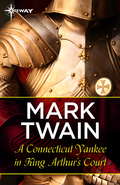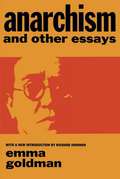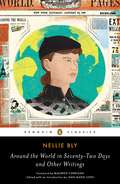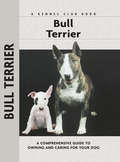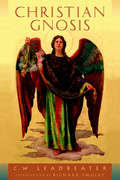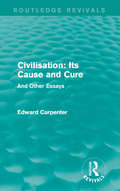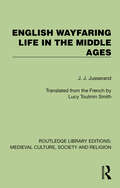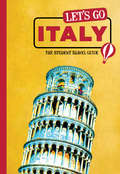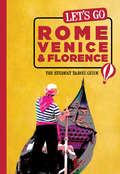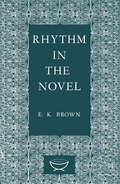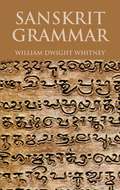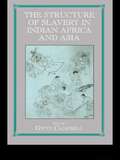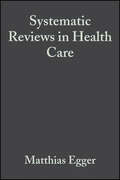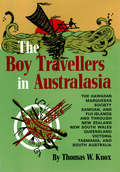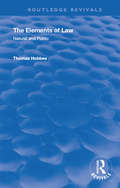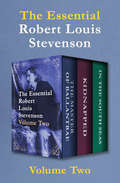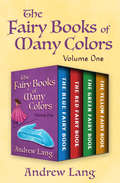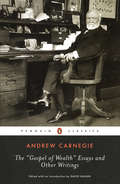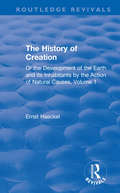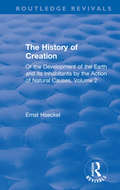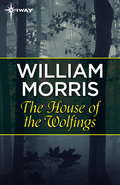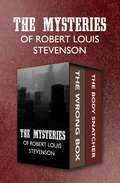- Table View
- List View
A Connecticut Yankee in King Arthur's Court
by Mark TwainA nineteenth-century American travels back in time to sixth-century England in this darkly comic social satire.
Anarchism and Other Essays
by Emma GoldmanIn the 1890s and for years thereafter, America reverberated with the name of the "notorious Anarchist," feminist, revolutionist, and agitator, Emma Goldberg. A Russian Jewish immigrant at the age of 17, she moved by her own efforts from seamstress in a clothing factory to internationally known radical lecturer, writer, editor, and friend of the oppressed. This book is a collection of her remarkably penetrating essays, far in advance of their time, originally published by the Mother Earth press which she founded.In the first of these essays, Anarchism: What It Really Stands For, she says, "Direct action, having proven effective along economic lines, is equally potent in the environment of the individual." In Minorities Versus Majorities she holds that social and economic well-being will result only through "the non-compromising determination of intelligent minorities, and not through the mass." Other pieces deal with The Hypocrisy of Puritanism; Prisons: A Social Crime and Failure; The Psychology of Political Violence; The Drama: A Powerful Disseminator of Radical Thought; Patriotism: A Menace to Liberty; and The Tragedy of Woman's Emancipation. A biographical sketch by Hippolyte Havel precedes the essays.Anarchism and Other Essays provides a fascinating look into revolutionary issues at the turn of the century, a prophetic view of the social and economic future, much of which we have seen take place, and above all, a glimpse into the mind of an extraordinary woman: brilliant, provocative, dedicated, passionate, and what used to be called "high-minded."
Around the World in Seventy-Two Days and Other Writings
by Nellie BlyA collection of the articles and writings of famed American journalist Nellie Bly. .
Bull Terrier
by Alice Van Kempen Bethany GibsonFiercely loyal with the heart of a gladiator, the "White Cavalier" (as the White Bull Terrier is known) is one of the world's most entertaining canines. Known for his clownish antics and his insatiable desire to have a good time, the egg-headed Bull Terrier, whether White or Colored, is a fun, adaptable dog able to live in the city, suburb, or country, an ideal choice for active families with children. This Comprehensive Owner's Guide is an excellent introduction to the breed, retelling the breed's history in England and America and detailing the breed's many special characteristics. Author Bethany Gibson is joined by Bull Terrier breeder and judge David Harris for a special section on the breed's development in the United States.New owners will welcome the well-prepared chapter on finding a reputable breeder and selecting a healthy, sound puppy. Chapters on puppy-proofing the home and yard, purchasing the right supplies for the puppy as well as house-training, feeding, and grooming are illustrated with photographs of handsome adults and puppies. In all, there are over 135 full-color photographs in this useful and reliable volume. The author's advice on obedience training will help the reader better mold and train into the most well-mannered dog in the neighborhood. The extensive and lavishly illustrated chapter on healthcare provides up-to-date detailed information on selecting a qualified veterinarian, vaccinations, preventing and dealing with parasites, infectious diseases, and more. Sidebars throughout the text offer helpful hints, covering topics as diverse as historical dogs, breeders, or kennels, toxic plants, first aid, crate training, carsickness, fussy eaters, and parasite control. Fully indexed.
Christian Gnosis
by Richard Smoley Charles Webster LeadbeaterThen shall the candidate be bound upon the wooden cross . . . After the third day he shall be brought back from the dead and carried up to heaven to be on the right hand of Him from whom he came. Surprisingly, these lines are from an Egyptian initiation ritual thousands of years before the Christian drama. Linking the two is just one fascinating element in this profound introduction to esoteric Christianity, as timely today as when it was first published in 1920. Famed clairvoyant Charles Webster Leadbeater was a bishop of the Liberal Catholic Church, which preserves the sacraments while interpreting the scriptures with maximum freedom. He quotes St. Augustine himself saying that what we now call Christianity emerged at the very beginning of humanity as the one true religion. To access its transformative force, Leadbeater returns to original teachings and decodes its story symbolically as a guide for direct knowledge (Gr: gnosis) of the Divine. "As Christ had the Godhead behind Him, so have we the same power, although not yet unfolded as fully," he says. "Nevertheless, it is only a question of development, and that development is certain." With the authority of a scientist and a mystic, he addresses such topics as the birth of Christ in the heart; God's utter love; divine grace; angelic help; the true meaning of salvation; and reincarnation and the evolution of the soul.
Christian Gnosis
by Richard Smoley C W LeadbeaterThen shall the candidate be bound upon the wooden cross . . . After the third day he shall be brought back from the dead and carried up to heaven to be on the right hand of Him from whom he came. Surprisingly, these lines are from an Egyptian initiation ritual thousands of years before the Christian drama. Linking the two is just one fascinating element in this profound introduction to esoteric Christianity, as timely today as when it was first published in 1920. Famed clairvoyant Charles Webster Leadbeater was a bishop of the Liberal Catholic Church, which preserves the sacraments while interpreting the scriptures with maximum freedom. He quotes St. Augustine himself saying that what we now call Christianity emerged at the very beginning of humanity as the one true religion. To access its transformative force, Leadbeater returns to original teachings and decodes its story symbolically as a guide for direct knowledge (Gr: gnosis) of the Divine. "As Christ had the Godhead behind Him, so have we the same power, although not yet unfolded as fully," he says. "Nevertheless, it is only a question of development, and that development is certain." With the authority of a scientist and a mystic, he addresses such topics as the birth of Christ in the heart; God's utter love; divine grace; angelic help; the true meaning of salvation; and reincarnation and the evolution of the soul.
Civilisation: And Other Essays (Routledge Revivals: The Collected Works of Edward Carpenter)
by Edward CarpenterThis volume, originally published in 1889 with this edition published in 1912, contains Carpenter's famous essays on civilisation and his theory that it is a disease of mankind that must be cured. Papers included in this collection discuss the rampant ill-health suffered by society as well as criticisms of modern science to support this theory whilst also analysing what the future holds for science, ideas of morality and traditions and customs. This title will be of interest to students of sociology.
English Wayfaring Life in the Middle Ages (Routledge Library Editions: Medieval Culture, Society, & Religion)
by J. J. JusserandOriginally published in 1889 and as a fourth edition in 1950, this book is a study of travel in fourteenth century England. It brings to life those contemporaries of Chaucer who passed up and down the highways for business or pleasure, whether they were minstrels, messengers, merchants, wandering preachers, friars or pilgrims. The book builds a picture not just of travel in Medieval England, but how those on such nomadic journeys felt and thought.
Let's Go Italy
by Harvard Student Agencies, Inc.Italy is the place for amazing food, the best vino, epic art, unparalleled natural beauties, and some seriously tight leather pants. The Let's Go student researchers endured gallons of gelato, pounds of pizza, miles of museums, countless clubs, and as many ruins as the Romans left behind - all to bring travelers the most comprehensive coverage of Italy, with plenty of witty asides. Get ready to experience adventure and la dolce far niente with Let's Go Italy.
Let's Go Rome, Venice & Florence
by Inc. Harvard Student AgenciesWelcome to Italy, the laid-back land of Roman majesty, Tuscan sunshine, and Venetian romance-at least, that's what they say in the tourist brochures. Our student researchers have lived the real vita bella-dodging rogue scooters, unscheduled bus strikes, and overeager Italian suitors-in order to bring you the coverage that really matters. Their irreverent, in-depth commentary will keep you entertained through scores of Michelangelos and Medicis, and guide you straight to the best gelaterias in town. Whether you're studying abroad in one city or hostel-hopping between all three, Let's Go Rome, Venice & Florence will prepare you for an adventure you'll never forget.Let's Go publishes the world's favorite student travel guides, written entirely by Harvard undergraduates. Armed with pens, notebooks, and a few changes of underwear stuffed in their backpacks, our student researchers go across continents, through time zones, and above expectations to seek out invaluable travel experiences for our readers. Let's Go has been on the road for 50 years and counting: We're on a mission to provide our readers with sharp, fresh coverage packed with socially responsible opportunities to go beyond tourism.
Rhythm in the Novel
by E. K. BrownThe Alexander Lectures for 1949-50. In his Preface, Professor Brown says, "Isolating a single element or group of elements in the novel, and considering it in unreal separation from all the other elements which it actually fuses, is artificial, but so is all criticism. The artificiality is justified if when one turns back from the criticism to the novels these appear more intelligible and more delightful. That is the test." Applying the test to Dr. Brown's present work, the method is more than justified by the results. they are titled: "Phrase, Character, Incident," "Expanding Symbols," "Interweaving Themes," and "Rhythm in E.M. Forster's A Passage to India."
Sanskrit Grammar
by William Dwight WhitneyAs Latin is key to the study of Western classics, so Sanskrit is the gateway to understanding ancient Indian literature. One of the few Sanskrit grammars currently available, this meticulously researched and thoughtfully assembled guide to the language's basics will prove valuable to students of Indian culture and history.Focusing on the fundamentals of Sanskrit as revealed in literary classics, the text follows the forms and constructions of the older language, as exhibited in the Veda and the Brahamana. It begins with an introduction to the Sanskrit alphabet, followed by a treatment of the accent -- its changes in combination and inflection, and the tone of the individual worlds. Succeeding chapters discuss declension, conjugation, parts of speech, and formation of compound stems. A helpful appendix, Sanskrit index, and general index conclude the text.
Structure of Slavery in Indian Ocean Africa and Asia
by Gwyn CampbellThe abolition of slavery in and around the Western Indian Ocean have been little studied. This collection examines the meaning of slavery and its abolition in relation to specific indigenous societies and to Islam, a religion that embraced the entire region, and draws comparisons between similar developments in the Atlantic system. Case studies include South Africa, Mauritius, Madagascar, the Benadir Coast, Arabia, the Persian Gulf and India. This volume marks an important new development in the study of slavery and its abolition in general, and an original approach to the history of slavery in the Indian Ocean and Asia regions.
Systematic Reviews in Health Care
by Douglas Altman Matthias Egger George Davey-SmithThe second edition of this best-selling book has been thoroughly revised and expanded to reflect the significant changes and advances made in systematic reviewing. New features include discussion on the rationale, meta-analyses of prognostic and diagnostic studies and software, and the use of systematic reviews in practice.
The Boy Travellers in Australasia
by Thomas W. KnoxHere is humor, especially in many of the illustrations; nostalgia and escapism. The author was one of the most colorful and popular figures on the New York scene at the height of his career in the 1880's. This fine book is just one of his many legacies, and is an invaluable contribution toward a better understanding of our fine friends Down Under.
The Boy Travellers in Australasia
by Thomas W. KnoxHere is humor, especially in many of the illustrations; nostalgia and escapism. The author was one of the most colorful and popular figures on the New York scene at the height of his career in the 1880's. This fine book is just one of his many legacies, and is an invaluable contribution toward a better understanding of our fine friends Down Under.
The Elements of Law: Natural and Politic (Routledge Revivals)
by Thomas HobbesOriginally published in 1889, Ferdinand Tonnies published versions of two works by Thomas Hobbes. His editions of The Elements of Law: Natural and Politic and of Behemoth: or The Long Parliament were the first modern critical editions, based on manuscripts of works by Hobbes. Completed in 1640, The Elements of Law was Hobbes's first systematic political work. The book helps us see Hobbes's mind at work, for it is the first version of his later political works.
The Essential Robert Louis Stevenson Volume Two: The Master of Ballantrae, Kidnapped, and In the South Seas
by Robert Louis StevensonTwo historical adventure novels from the author of Treasure Island, as well as a rare travel memoir of his experiences in the Pacific Islands.The Master of Ballantrae: In this tragic tale of a family divided by the eighteenth-century Jacobite rising, two brothers join opposing sides of the conflict. The story follows their epic rivalry from Scotland to the high seas and the American wilderness.Kidnapped: This adventure novel, inspired by true events in eighteenth-century Scotland, tells the tale of young David Balfour—who is betrayed by his uncle and kidnapped onto a ship, and survives shipwreck with his friend, the famous Jacobite Alan Breck Stewart.In the South Seas: In the 1890s, Robert Louis Stevenson chartered a ship to the Pacific Islands and recorded his experiences and observations. This autobiography of his journey offers a rare window into the author&’s real, adventurous life.
The Fairy Books of Many Colors Volume One: The Blue Fairy Book, The Red Fairy Book, The Green Fairy Book, and The Yellow Fairy Book (The Fairy Books of Many Colors)
by Andrew LangFour volumes in the influential series of folklore and fairy tales collected from many cultures—for children of all ages. In a time when fairy tales were dismissed, even condemned, by academics and critics, Andrew Lang and his wife, Leonora Blanche Alleyne, worked to compile a multitude of these stories—not only helping them gain great popularity among everyday readers but also changing the widespread perceptions of this kind of literature. This entertaining volume brings together four of Lang&’s collections—The Blue Fairy Book, The Red Fairy Book, The Green Fairy Book, and The Yellow Fairy Book—totaling more than 150 stories.
The Gospel of Wealth Essays and Other Writings
by Andrew CarnegieWords of wisdom from American philanthropist Andrew Carnegie Focusing on Carnegie's most famous essay, "The Gospel of Wealth," this book of his writings, published here together for the first time, demonstrates the late steel magnate's beliefs on wealth, poverty, the public good, and capitalism. Carnegie's commitment to ensuring and promoting the welfare of his fellow human beings through philanthropic deeds ranged from donations to universities and museums to establishing more than 2,500 public libraries in the English-speaking world, and he gave away more than $350 million toward those efforts during his lifetime. The Gospel of Wealth is an eloquent testament to the importance of charitable giving for the public good. .
The History of Creation: Or the Development of the Earth and its Inhabitants by the Action of Natural Causes, Volume 1 (Routledge Revivals)
by Ernst HaeckelOriginally published in 1899, The History of Creation was the first book of its kind to apply a doctrine to the whole range of organic morphology and make use of the effect Darwin had on biological sciences during the 19th century. Haeckel looks at Darwin’s reform of Descent Theory and its establishment through the doctrine of selection. He introduces Descent Theory into the systematic classification of animals and plants and finds a "natural system" on the basis of genealogy - that is, to construct hypothetical pedigrees for the various species of organisms. The book will be of interest to those studying natural history and the origins of modern scientific thought, it will appeal to researchers both in the natural sciences and in history.
The History of Creation: Or the Development of the Earth and its Inhabitants by the Action of Natural Causes, Volume 2 (Routledge Revivals)
by Ernst HaeckelOriginally published in 1899, The History of Creation was the first book of its kind to apply a doctrine to the whole range of organic morphology and make use of the effect Darwin had on biological sciences during the 19th century. Haeckel looks at Darwin’s reform of Descent Theory and its establishment through the doctrine of selection. He introduces Descent Theory into the systematic classification of animals and plants and finds a "natural system" on the basis of genealogy - that is, to construct hypothetical pedigrees for the various species of organisms. The book will be of interest to those studying natural history and the origins of modern scientific thought, it will appeal to researchers both in the natural sciences and in history.
The House of the Wolfings: A Tale Of The House Of The Wolfings And All The Kindreds Of The Mark
by William MorrisThe tale tells that in times long past there was a dwelling of men beside a great wood. Before it lay a plain, not very great, but which was, as it were, an isle in the sea of woodland, since even when you stood on the flat ground, you could see trees everywhere in the offing, though as for hills, you could scarce say that there were any; only swellings-up of the earth here and there, like the upheavings of the water that one sees at whiles going on amidst the eddies of a swift but deep stream.The tale of the House of the Wolfings in its struggles against the legionaries of Rome then advancing into Northern Germany.
The House of the Wolfings: A Tale Of The House Of The Wolfings And All The Kindreds Of The Mark Written In Prose And In Verse
by William MorrisThe tale tells that in times long past there was a dwelling of men beside a great wood. Before it lay a plain, not very great, but which was, as it were, an isle in the sea of woodland, since even when you stood on the flat ground, you could see trees everywhere in the offing, though as for hills, you could scarce say that there were any; only swellings-up of the earth here and there, like the upheavings of the water that one sees at whiles going on amidst the eddies of a swift but deep stream.The tale of the House of the Wolfings in its struggles against the legionaries of Rome then advancing into Northern Germany.
The Mysteries of Robert Louis Stevenson: The Wrong Box and The Body Snatcher
by Robert Louis StevensonA short thriller and a comic crime novel by the author of The Strange Case of Dr. Jekyll and Mr. Hyde explore murderous greed in nineteenth-century Scotland.The Wrong Box: Two elderly brothers, Joseph and Masterman, are the last surviving members of an investment agreement known as a tontine. All their two nephews have to do to inherit everything is make sure Joseph outlives Masterman. But that&’s easier said than done. Robert Louis Stevenson cowrote this comic crime novel with his stepson Lloyd Osbourn.The Body Snatcher: Inspired by the notorious Burke and Hare murders, this chilling short story tells the tale of two medical students in charge of receiving human cadavers for dissection in their anatomy class. When one of them begins to suspect murder is afoot, the other starts acting increasingly suspicious—until both find themselves in a terrifying predicament.
